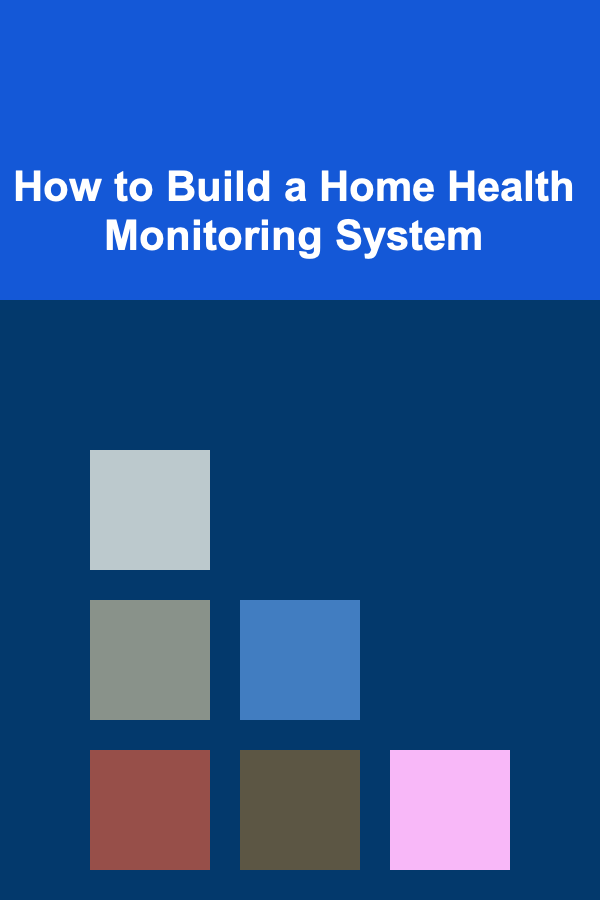
How to Build a Home Health Monitoring System
ebook include PDF & Audio bundle (Micro Guide)
$12.99$10.99
Limited Time Offer! Order within the next:

In today's world, health is a primary concern for most people, and the need for reliable and continuous health monitoring has never been greater. With advancements in technology, the concept of home health monitoring has emerged as a solution that empowers individuals to track and manage their health from the comfort of their homes. Building a home health monitoring system can help patients with chronic conditions, elderly people, and even those who just want to keep an eye on their general health metrics. This article outlines how to design and build an effective home health monitoring system, incorporating both the hardware and software components, along with key considerations for scalability, reliability, and privacy.
Understanding the Components of a Home Health Monitoring System
A comprehensive home health monitoring system involves several key components, ranging from sensors that collect data to software that processes, stores, and analyzes this data. To build a robust system, it's essential to understand the core elements involved.
1.1. Sensors and Devices
The heart of any home health monitoring system lies in the sensors and devices that gather data on a person's health. These sensors measure various health parameters and may include:
- Heart rate monitors: Devices that measure heart rate variability and pulse.
- Blood pressure monitors: For tracking systolic and diastolic blood pressure levels.
- Thermometers: To monitor body temperature, providing insights into fever or infection.
- Glucose meters: Essential for diabetics to monitor blood sugar levels.
- Oximeters: To measure blood oxygen saturation (SpO2), which is particularly useful for individuals with respiratory conditions.
- Weight scales: For monitoring weight fluctuations, which can help detect early signs of health issues like fluid retention.
- Wearables: Such as smartwatches or fitness trackers that monitor multiple parameters, including heart rate, physical activity, sleep patterns, and calories burned.
The sensors should be capable of transmitting data in real-time to a central hub, ensuring that health information is constantly updated.
1.2. Central Hub (Data Aggregator)
The central hub acts as the brain of the health monitoring system. This could be a smartphone, tablet, or a dedicated health monitoring device. It aggregates data from all sensors and prepares it for processing. The central hub must have connectivity capabilities, such as Bluetooth, Wi-Fi, or cellular data, to sync the data from various sensors to a cloud platform or a local server.
In more advanced setups, the central hub can be built on a Raspberry Pi , a microcontroller , or a home server that runs software designed to process the data.
1.3. Data Storage and Cloud Integration
For a home health monitoring system to function effectively over time, data storage is vital. Since health metrics can change frequently, it's crucial to store this data in a secure and scalable environment. The two primary storage options are:
- Cloud storage: Platforms such as Google Cloud, AWS, and Microsoft Azure offer scalable, secure, and accessible data storage solutions. Cloud storage allows you to securely store vast amounts of health data and provides flexibility in terms of access, sharing, and analytics.
- Local storage: Some users may prefer storing their data on a local server to ensure complete control over privacy. However, local storage solutions may lack the scalability and accessibility of cloud options.
Data storage should also incorporate encryption to ensure patient confidentiality and compliance with data privacy regulations (e.g., HIPAA in the U.S. or GDPR in Europe).
1.4. Software for Data Processing and Analysis
Once the data is collected and stored, it needs to be processed and analyzed to derive meaningful insights. The software layer consists of:
- Data processing algorithms: These include filters, transformations, and other techniques to process raw data into actionable information. For instance, raw ECG data from a heart monitor may need to be filtered to remove noise and provide clean heart rate data.
- Analytics software: Machine learning or AI-based algorithms can be integrated to detect trends or potential health issues. For example, an AI system could track patterns over time to predict the onset of health problems such as hypertension or diabetes.
The software must be user-friendly and accessible through a web portal or a mobile app that provides intuitive dashboards, visualizations, and notifications to users.
1.5. User Interface (UI) and Experience (UX)
The user interface plays a critical role in ensuring that the monitoring system is accessible and easy to use. The UI design should be:
- Simple and intuitive: Especially for elderly users or individuals not familiar with technology.
- Real-time feedback: Users should receive immediate notifications or warnings if their health data indicates something unusual.
- Customizable: Users should be able to set preferences and receive tailored reports.
- Accessible: Support for multiple devices such as smartphones, tablets, and even smart TVs.
Building the Home Health Monitoring System: A Step-by-Step Guide
2.1. Select the Right Sensors and Devices
The first step in building the system is to select the right health monitoring devices based on the target users and their health needs. A person with diabetes may need a blood glucose monitor, while an elderly person may benefit more from a blood pressure cuff and a heart rate monitor. It's essential to choose devices that are reliable, FDA-approved, and capable of transmitting data securely.
2.2. Establish Connectivity Between Devices and the Central Hub
Once the devices are selected, the next task is to establish connectivity. Most modern sensors come with Bluetooth, Wi-Fi, or even cellular connectivity. For the central hub (smartphone, tablet, etc.), you'll need to install the required applications that can interface with the devices, whether it's through an API or a proprietary protocol.
For example, a smart scale might connect directly to a mobile app via Bluetooth, while a blood pressure monitor might sync with a Raspberry Pi hub that aggregates the data.
2.3. Set Up the Data Storage and Cloud Infrastructure
Setting up the storage infrastructure is the next critical step. If you're using cloud storage, choose a provider that ensures compliance with data privacy laws and offers secure access control. If you prefer local storage, you'll need a home server with sufficient capacity for long-term data retention.
Ensure that data encryption is implemented at every stage: both in transit (using HTTPS) and at rest (using AES or similar encryption standards).
2.4. Implement Software for Data Processing and Visualization
Develop or use existing software to process and analyze the data. A popular choice is to integrate Machine Learning models that can track health trends over time and issue alerts if abnormal patterns are detected. For instance:
- Heart rate spikes can be detected, signaling potential arrhythmias.
- Blood pressure patterns can help predict future hypertension episodes.
- Glucose trends can help manage diabetes.
Once processed, the data should be visualized in easy-to-understand charts and graphs on a user interface (mobile app or web portal). You can use visualization libraries like D3.js or Plotly for web apps, or Charts.js for mobile app development.
2.5. Design the User Interface
Design an intuitive, easy-to-navigate interface. It should include:
- Dashboard: Displaying real-time data from all sensors in a simple, at-a-glance format.
- Historical Data View: Graphs and charts showing trends over time (e.g., heart rate, blood pressure).
- Alerts and Notifications: Real-time notifications if readings go outside of predefined thresholds.
- Customization Options: Allow users to configure thresholds for different health parameters, choose alert preferences, and customize the frequency of reports.
2.6. Testing and Validation
Before deploying the system to users, thorough testing is essential. Some aspects to consider include:
- Accuracy: Verify that the sensors provide accurate and reliable readings.
- Scalability: Ensure the system can handle an increasing number of users or sensors without compromising performance.
- Security: Test the encryption and security protocols to ensure compliance with privacy regulations and prevent unauthorized access.
2.7. Deploying and Monitoring
After testing, deploy the system and monitor its performance. Ensure that the users receive the expected benefits, such as easy health tracking and alerts. Continuous monitoring of the system can also help in fine-tuning performance and identifying areas for improvement.
Challenges and Considerations in Building a Home Health Monitoring System
While building a home health monitoring system is highly rewarding, there are several challenges and considerations to keep in mind:
3.1. Data Privacy and Security
The most crucial concern when dealing with health data is privacy. Ensure the system complies with regulations such as HIPAA or GDPR to protect user data. Implement strong encryption and access control measures to safeguard patient information.
3.2. Sensor Accuracy and Reliability
The accuracy of health sensors is vital for the system to provide valid insights. Sensors must be FDA-approved or certified by relevant health authorities to ensure they meet required standards.
3.3. Battery Life and Power Consumption
Wearable devices and sensors often rely on battery power. Designing a system that minimizes power consumption while maintaining continuous monitoring can be a challenge.
3.4. Integration with Other Healthcare Systems
A fully-fledged home health monitoring system should be able to integrate with existing healthcare infrastructure, such as Electronic Health Records (EHR). This integration allows healthcare providers to track their patients' health remotely and intervene when necessary.
3.5. User Adoption
For many users, especially the elderly or those unfamiliar with technology, the system must be intuitive. This can often mean designing a simpler version of the system for those less technologically inclined.
The Future of Home Health Monitoring Systems
As technology advances, the future of home health monitoring systems looks promising. With the integration of AI, machine learning, and IoT devices, these systems will become smarter and more predictive. Future systems will likely incorporate more personalized health insights and predictive analytics, allowing for proactive health management rather than reactive care.
Moreover, the development of wearable health technologies such as continuous glucose monitors (CGMs), advanced ECG monitors, and AI-powered health trackers will significantly improve the comprehensiveness of at-home health monitoring.
Conclusion
Building a home health monitoring system requires a blend of hardware, software, and privacy considerations. From selecting the right sensors to implementing secure data storage and creating user-friendly interfaces, the process is both challenging and rewarding. As technology continues to evolve, these systems will play a pivotal role in empowering individuals to monitor their health in real time, ultimately leading to better outcomes and improved quality of life. The future is bright for home health monitoring, and it will undoubtedly transform the way we approach healthcare.

How to Make the Most of Commuting Time for Busy Dads
Read More
How to Run Promotions and Discounts to Boost Sales for Automotive Products
Read More
How to Soundproof Your Walls Without Major Renovations
Read More
How To Master Twists for Detoxification
Read More
Understanding the Economy's Impact on Your Finances
Read More
10 Tips for Using AI Tools to Enhance SEO Strategies
Read MoreOther Products

How to Make the Most of Commuting Time for Busy Dads
Read More
How to Run Promotions and Discounts to Boost Sales for Automotive Products
Read More
How to Soundproof Your Walls Without Major Renovations
Read More
How To Master Twists for Detoxification
Read More
Understanding the Economy's Impact on Your Finances
Read More